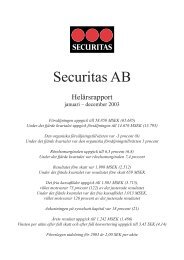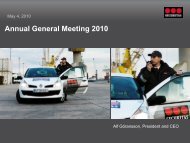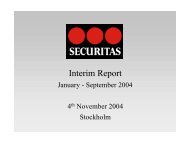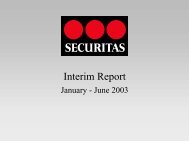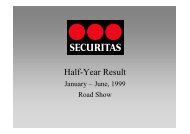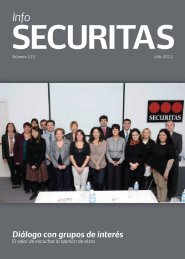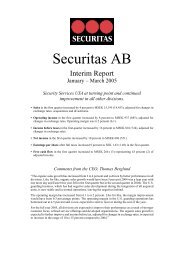Annual Report 2008 - Securitas
Annual Report 2008 - Securitas
Annual Report 2008 - Securitas
You also want an ePaper? Increase the reach of your titles
YUMPU automatically turns print PDFs into web optimized ePapers that Google loves.
Joint ventures (IAS 31)<br />
The proportional method is applied to joint ventures in which there is a<br />
shared controlling interest. According to this method, all statement of income<br />
and balance sheet items are stated in the consolidated statement of income,<br />
the consolidated statement of cash flow and the consolidated balance sheet<br />
in proportion to ownership. The proportional method of consolidation is<br />
used with effect from the date when a shared controlling interest is achieved<br />
and up until a shared controlling interest ceases to exist.<br />
Translation of foreign subsidiaries (IAS 21)<br />
The functional currency of each Group company is determined by the primary<br />
economic environment in which the company operates, that is the<br />
currency in which the company primarily generates and expends cash. The<br />
functional currency of the Parent company and the presentation currency<br />
of the Group, that is the currency in which the financial statements are<br />
presented, is the Swedish krona (SEK).<br />
The financial statements of each foreign subsidiary are translated according<br />
to the following method: Each month’s statement of income is translated<br />
using the exchange rate prevailing on the last day of the month, which<br />
means that income for each month is not affected by foreign exchange fluctuations<br />
during subsequent periods. Balance sheets are translated using<br />
exchange rates prevailing at each balance sheet date. Translation differences<br />
arising in the conversion of balance sheets are posted directly to equity<br />
and thus do not affect income for the year. The translation difference arising<br />
because statements of income are translated using average rates, while<br />
balance sheets are translated using exchange rates prevailing at each balance<br />
sheet date, is posted directly to equity. where loans have been raised<br />
to reduce the Group’s foreign exchange/translation exposure in foreign net<br />
assets, and qualify for the hedge accounting criteria, exchange rate differences<br />
on such loans are recognized together with the exchange rate differences<br />
arising from the translation of foreign net assets in the translation<br />
reserve in equity. when a foreign operation or part thereof is sold, such<br />
exchange differences are recognized in the statement of income as part of<br />
the gain or loss on sale.<br />
Goodwill and fair value adjustments arising on the acquisition of a foreign<br />
entity are treated as assets and liabilities of the foreign entity and translated<br />
at the closing rate.<br />
Transactions and balance sheet items in foreign currency<br />
(IAS 21)<br />
Transactions in foreign currency are translated into the functional currency in<br />
accordance with the exchange rates prevailing at the date of the transaction.<br />
Exchange differences on monetary items are recognized in the statement of<br />
income when they arise, with the exception of net investment hedges recognized<br />
via translation reserve in equity (see above under the section Translation<br />
of foreign subsidiaries). Exchange differences from operating items are<br />
recognized as either production expenses or selling and administrative<br />
expenses, while exchange differences from financial items are recognized<br />
as financial income or financial expense.<br />
When preparing the financial statements of individual companies, foreign<br />
currency denominated receivables and liabilities are translated to the functional<br />
currency of the individual company using the exchange rates prevailing<br />
at each balance sheet date.<br />
Revenue recognition (IAS 11 and IAS 18)<br />
The Group’s revenue is generated from various types of security services as<br />
well as from some remaining revenue arising from the sale of alarm products.<br />
Revenue from services is recognized in the period in which it is earned.<br />
Alarm installations are recognized in revenue as they are completed, in<br />
accordance with the percentage of completion method. According to this<br />
method, revenue, expenses, and thus, income are recognized in the period<br />
in which the work was undertaken. The determination of the percentage of<br />
alarm installations that can be recognized as revenue is based on the time<br />
spent in relation to the total estimated time.<br />
Trademark fees from the former subsidiary <strong>Securitas</strong> Direct AB, relating<br />
to the use of the <strong>Securitas</strong> trademark, are recognized on an accrual basis in<br />
accordance with the substance of the agreement, and are based on the<br />
sales recognized by <strong>Securitas</strong> Direct AB. Trademark fees from the former<br />
subsidiary Niscayah Group AB (former <strong>Securitas</strong> Systems AB) have been<br />
recognized up until November <strong>2008</strong>, based on the sales recognized by<br />
Niscayah Group AB.<br />
Interest income and borrowing costs are recognized in the statement of<br />
income in the period to which they are attributable.<br />
Segment reporting (IAS 14)<br />
The Group’s operations are divided into three primary segments (Security<br />
Services North America, Security Services Europe and Mobile and Monitoring)<br />
that provide the operational structure for governance, monitoring and<br />
reporting. The previous primary segment Loomis is included in the <strong>Securitas</strong><br />
Group up to December 8, <strong>2008</strong> and reported as Discontinued operations.<br />
Other includes general administrative expenses, expenses for head offices<br />
and other central expenses that according to IAS 14 should be excluded<br />
from the segments as relating to the Group as a whole. The Group’s joint<br />
venture <strong>Securitas</strong> Direct S.A. (Switzerland) as well as the guarding operations<br />
in Latin America and Asia are also included in Other. Moreover, the<br />
assets and liabilities of each segment include only those items that have<br />
been utilized or arisen in ongoing operations. Non-operational balance<br />
sheet items, primarily current tax, deferred tax, and provisions for taxes, are<br />
accounted for under the Other heading in the table capital employed and<br />
financing in Note 9. In the table Assets and liabilities in the same note, these<br />
items are accounted for as Unallocated non-interest bearing assets and<br />
Unallocated non-interest bearing liabilities. For further information regarding<br />
the segments operations, refer to Note 9. The secondary segments are the<br />
geographical areas in which the Group is active: Nordic region, Europe<br />
excluding Nordic region, North America and the operations outside these<br />
regions included in the rest of world. The geographical breakdown represents<br />
various levels of market development in terms of wages, employee turnover,<br />
product mix, market growth and profitability. The total sales for each geographical<br />
segment are based on the location of the sales. The location of<br />
the sales corresponds in all material aspects to the location of the customers.<br />
Accounting for government grants and disclosure<br />
of government assistance (IAS 20)<br />
<strong>Securitas</strong> like other employers is eligible for a variety of grants relating to<br />
employees. These grants relate to training, incentives for hiring new staff,<br />
reduction of working hours, etc. All grants are accounted for in the statement<br />
of income as a cost reduction in the same period as the related underlying<br />
cost.<br />
Taxes (IAS 12)<br />
<strong>Annual</strong> report<br />
Notes and comments to the consolidated financial statements<br />
Deferred income tax is provided in full, using the liability method, on temporary<br />
differences arising between the tax bases of assets and liabilities and<br />
their carrying amounts in the consolidated financial statements. However, if<br />
the deferred income tax arises from initial recognition of an asset or liability<br />
in a transaction other than a business combination that at the time of the<br />
transaction affects neither accounting nor taxable profit or loss, it is not<br />
accounted for. Deferred income tax is determined using tax rates (and laws)<br />
that have been enacted or substantially enacted by the balance sheet date<br />
and are expected to apply when the related deferred income tax asset is realized<br />
or the deferred income tax liability is settled.<br />
A deferred tax asset is recognized when it is probable that sufficient taxable<br />
income will arise that the deferred tax asset can be offset against. Deferred<br />
tax assets are valued as of the balance sheet date, and any potential<br />
previously unvalued deferred tax asset is recognized when it is expected to<br />
be usable, or correspondingly, reduced when it is expected to be wholly or<br />
partly unusable against future taxable income.<br />
current and deferred taxes are posted directly to shareholders’ equity if<br />
the relevant underlying transaction or event is posted directly to shareholders’<br />
equity in the period, or previous period if it pertains to an adjustment of an<br />
opening balance of retained earnings as the result of a change in accounting<br />
principle, or if it relates to exchange rate differences in the translation of the<br />
balance sheets of foreign subsidiaries that are posted to shareholders’ equity.<br />
<strong>Securitas</strong> <strong>Annual</strong> report <strong>2008</strong><br />
71




